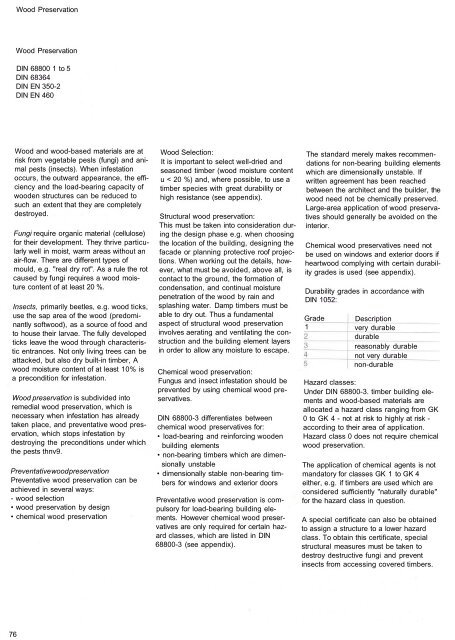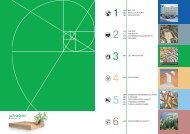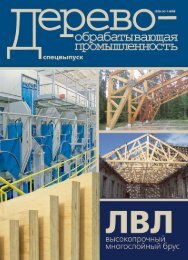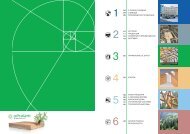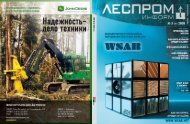Timber Construction
Timber Construction
Timber Construction
You also want an ePaper? Increase the reach of your titles
YUMPU automatically turns print PDFs into web optimized ePapers that Google loves.
Wood Preservation Wood Preservation<br />
Wood Preservation<br />
DIN 68800 1 to 5<br />
DIN 68364<br />
DIN EN 350-2<br />
DIN EN 460<br />
Wood and wood-based materials are at<br />
risk from vegetable pesls (fungi) and animal<br />
pests (insects). When infestation<br />
occurs, the outward appearance, the efficiency<br />
and the load-bearing capacity of<br />
wooden structures can be reduced to<br />
such an extent that they are completely<br />
destroyed.<br />
Fungi require organic material (cellulose)<br />
for their development. They thrive particularly<br />
well in moist, warm areas without an<br />
air-flow. There are different types of<br />
mould, e.g. "real dry rot". As a rule the rot<br />
caused by fungi requires a wood moisture<br />
content of at least 20 %.<br />
Insects, primarily beetles, e.g. wood ticks,<br />
use the sap area of the wood (predominantly<br />
softwood), as a source of food and<br />
to house their larvae. The fully developed<br />
ticks leave the wood through characteristic<br />
entrances. Not only living trees can be<br />
attacked, but also dry built-in timber, A<br />
wood moisture content of at least 10% is<br />
a precondition for infestation.<br />
Wood preservation is subdivided into<br />
remedial wood preservation, which is<br />
necessary when infestation has already<br />
taken place, and preventative wood preservation,<br />
which stops infestation by<br />
destroying the preconditions under which<br />
the pests thnv9.<br />
Preventative wood preservation<br />
Preventative wood preservation can be<br />
achieved in several ways:<br />
- wood selection<br />
• wood preservation by design<br />
• chemical wood preservation<br />
Wood Selection:<br />
It is important to select well-dried and<br />
seasoned timber (wood moisture content<br />
u < 20 %) and, where possible, to use a<br />
timber species with great durability or<br />
high resistance (see appendix).<br />
Structural wood preservation:<br />
This must be taken into consideration during<br />
the design phase e.g. when choosing<br />
the location of the building, designing the<br />
facade or planning protective roof projections.<br />
When working out the details, however,<br />
what must be avoided, above all, is<br />
contact to the ground, the formation of<br />
condensation, and continual moisture<br />
penetration of the wood by rain and<br />
splashing water. Damp timbers must be<br />
able to dry out. Thus a fundamental<br />
aspect of structural wood preservation<br />
involves aerating and ventilating the construction<br />
and the building element layers<br />
in order to allow any moisture to escape.<br />
Chemical wood preservation:<br />
Fungus and insect infestation should be<br />
prevented by using chemical wood preservatives.<br />
DIN 68800-3 differentiates between<br />
chemical wood preservatives for:<br />
• load-bearing and reinforcing wooden<br />
building elements<br />
• non-bearing timbers which are dimensionally<br />
unstable<br />
• dimensionally stable non-bearing timbers<br />
for windows and exterior doors<br />
Preventative wood preservation is compulsory<br />
for load-bearing building elements.<br />
However chemical wood preservatives<br />
are only required for certain hazard<br />
classes, which are listed in DIN<br />
68800-3 (see appendix).<br />
The standard merely makes recommendations<br />
for non-bearing building elements<br />
which are dimensionally unstable. If<br />
written agreement has been reached<br />
between the architect and the builder, the<br />
wood need not be chemically preserved.<br />
Large-area application of wood preservatives<br />
should generally be avoided on the<br />
interior.<br />
Chemical wood preservatives need not<br />
be used on windows and exterior doors if<br />
heartwood complying with certain durability<br />
grades is used (see appendix).<br />
Durability grades in accordance with<br />
DIN 1052:<br />
Grade<br />
1<br />
Description<br />
very durable<br />
durable<br />
reasonably durable<br />
not very durable<br />
non-durable<br />
Hazard classes:<br />
Under DIN 68800-3. timber building elements<br />
and wood-based materials are<br />
allocated a hazard class ranging from GK<br />
0 to GK 4 - not at risk to highly at risk -<br />
according to their area of application.<br />
Hazard class 0 does not require chemical<br />
wood preservation.<br />
The application of chemical agents is not<br />
mandatory for classes GK 1 to GK 4<br />
either, e.g. if timbers are used which are<br />
considered sufficiently "naturally durable"<br />
for the hazard class in question.<br />
A special certificate can also be obtained<br />
to assign a structure to a lower hazard<br />
class. To obtain this certificate, special<br />
structural measures must be taken to<br />
destroy destructive fungi and prevent<br />
insects from accessing covered timbers.<br />
A wood moisture content of below 20 per<br />
cent is required to avoid fungal decay.<br />
Insect attacks can be prevented by taking<br />
structural protection measures, e.g.<br />
by using suitable cladding or by keeping<br />
the wood moisture content below 10 per<br />
cent. If the wood remains open and can<br />
be inspected for insect attacks, chemical<br />
od preservatives can also be avoided,<br />
'e.g. in undeveloped roof trusses, if<br />
accessibility is ensured.<br />
Nearly all load-bearing and reinforcing<br />
building elements can be classified as<br />
GK 0, with the exception of sills (GK 2).<br />
Chemical wood preservatives can also be<br />
[dispensed with here if sap-free pine,<br />
'larch or Douglas fir is used.<br />
Chemical wood preservatives:<br />
Wood preservation by design should be<br />
given priority in every case when building<br />
wood constructions. If it is pursued consistently<br />
chemical wood preservatives can<br />
be avoided completely. Even under DIN,<br />
preventative chemical wood preservation<br />
is only a supplementary measure, and<br />
should be taken only when wood selection<br />
and design measures prove inadequate.<br />
DIN 68800-3 specifies how the wood<br />
preservatives are to be applied:<br />
• according to the inspection grades:<br />
- insect repelling Iv<br />
- inimical to mould P<br />
- weatherproof W<br />
- inimical to mildew E,<br />
each preservative can be applied individually<br />
or in combination depending on<br />
the hazard class.<br />
• according to the wood species (round<br />
timber, sawn timber, laminated wood ...)<br />
• according to the method of application<br />
(painting, spraying, dipping, borehole<br />
impregnation, vacuum and boiler pressure<br />
impregnation ...), including possible<br />
pre-treatments of wood species<br />
that are difficult to impregnate and the<br />
appropriate amounts to be applied for<br />
the hazard classes stipulated, whilst<br />
observing occupational health and<br />
safety measures.<br />
Pay attention to the manufacturers'<br />
instructions.<br />
Wood preservatives can be divided into:<br />
• water soluble wood preservatives,<br />
• solvent based wood preservatives,<br />
• oleaginous wood preservatives.<br />
Water soluble wood preservatives:<br />
These preservatives contain inorganic or<br />
organic salts as agents which act as<br />
biocides.<br />
A problem with inorganic water-soluble<br />
wood preservative salts is leaching caused<br />
by moisture, e.g. rain. Salts for hazard<br />
classes 1 and 2 are always leachable and<br />
need to be covered on site to protect them<br />
against moisture. Non-leachable salts for<br />
hazard classes 3 and 4 contain chromates<br />
(chrome-VI-compounds) and require a fixing<br />
period of several weeks in the wood.<br />
They need to be stored and protected from<br />
rain during this time.<br />
Organic water-soluble salts are approved<br />
for hazard classes 3 and 4 and fix in<br />
wood without the addition of chromates.<br />
Solvent based wood preservatives:<br />
These comprise organic solvents and<br />
organic compounds which act as biocides.<br />
There is a controversial public<br />
debate about some of the fungicides and<br />
insecticides used (e.g. pyrethroid). Specific<br />
problems arise when pentachlorophenol<br />
(PCP) and lindane-containing<br />
agents are used indoors. For this reason<br />
PCP has been banned in Germany since<br />
1990.<br />
Oleaginous wood preservatives:<br />
These are creosote compounds and<br />
creosoles.<br />
Processing:<br />
For reasons of occupational health and<br />
safety during processing, and to protect<br />
subsequent occupants from exposure to<br />
the agents and solvents contained in the<br />
wood, it is principally recommended that<br />
closed equipment be used to introduce the<br />
preservatives into the wood (boiler pressure<br />
impregnation, possibly also trough<br />
impregnation, spray tunnel procedure).<br />
The processing of wood preservatives on<br />
the construction site should be limited to<br />
the treatment of sawn edges, etc. Furthermore,<br />
the wood preservative should be<br />
applied by brush and not sprayed.<br />
Identification:<br />
Only products whose effectiveness and<br />
harmlessness have been demonstrated in<br />
tests may be used as chemical wood preservatives.<br />
They are subject to the<br />
approval mark regulation of the German<br />
Lander and are issued with the Institute of<br />
Structural Engineering in Berlin approval<br />
mark when their usability has been<br />
proven,<br />
The area of constructed wood that has<br />
been treated must be provided with longterm<br />
visible identification by the contractor<br />
in accordance with DIN 68800-3.<br />
Waste disposal:<br />
Remains of wood preservatives as well as<br />
empty containers and contaminated<br />
packages are hazardous waste. <strong>Timber</strong><br />
treated with wood preservatives must be<br />
incinerated as hazardous waste. Landfilling<br />
is prohibited.<br />
Manufacturer(s) (selection)<br />
AURO-Pflanzenchemie GmbH<br />
BeeckGmbH 8 Co KG<br />
Desowag GmbH<br />
Kulba-Bauchemie GmbH<br />
Leinos-Naturfarben GmbH<br />
Livos Pflanzenchemie GmbH<br />
RCH Fluorchemie GmbH<br />
Remmers Chmie GmbH & Co<br />
Wehl GmbH<br />
Dr. Wolmann GmbH<br />
Information<br />
The Deutsche Institut fur Bautechnik<br />
(DIBt) Berlin (German Institute for Structural<br />
Engineering) issues a list of<br />
approved wood preservation products<br />
annually.<br />
Gutegemeinschaft Holzschutzmirtel e.V.<br />
76 77


